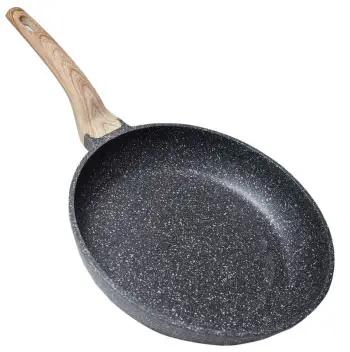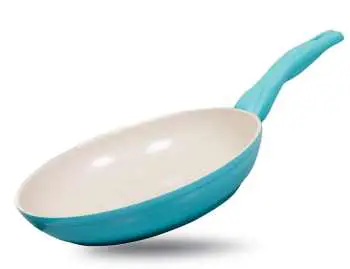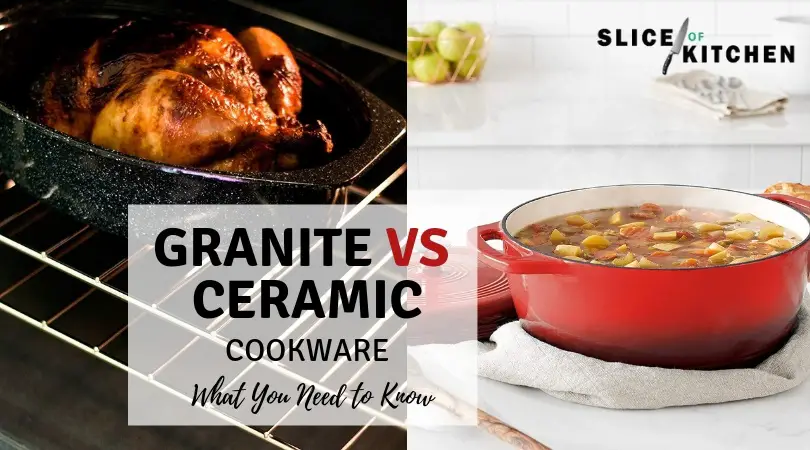If you’re looking for nonstick cookware that can replace your Teflon-coated pans, then you’ve probably heard of granite cookware and ceramic cookware. But just how are they different? Which one is better in terms of performance and non toxicity? I’ll explore this topic in detail in this post.
Though they are made of different materials, granite cookware and ceramic cookware are almost equal when it comes to performance, safety, and durability. Ceramic cookware does hold an edge over granite in terms of color variations and heat retention, however.
If you’re wondering if either granite or ceramic cookware can replace your Teflon-coated pots and pans, the simple answer is yes. Top quality graniteware and ceramic cookware can prevent food from sticking, and can be a lot safer to boot.
Table of Contents
What Is Granite Cookware?

Granite cookware is one of the many types of enamelware. It typically consists of a carbon steel core which is coated with porcelain enamel. Despite its name, it doesn’t contain any granite and is only named as such because of its similarity in appearance.
Advantages
Though modern graniteware is no longer as sturdy as those that our ancestors used to have, it still comes with a lot of advantages.
- Unlike cast iron, this type of cookware doesn’t rust.
- The porcelain enamel that is typically used is inert, so you can safely cook acidic ingredients without it affecting the flavor and smell of your dishes.
- The granite cookware of the modern world don’t contain harmful chemicals that might affect our health.
- The carbon steel or aluminum core heats up quickly. This can speed up cooking time.
- Granite cookware is lighter in weight than cast iron.
- Its smooth and glossy surface makes cleanup a piece of cake.
Disadvantages
Just like any other product, granite cookware comes with disadvantages too.
- It isn’t suitable for glass stovetops as it can break the glass.
- Unlike older versions which have thicker layers, modern graniteware is very thin. This results in poor heat retention.
- Granite cookware is fragile and should be handled carefully to prevent chipping the enamel coating. Wooden or plastic kitchen utensils should be used when cooking.
- Though a lot of manufacturers claim that their granite cookware is nonstick, a lot of buyers still find their food sticking to the cooking surface.
What Is Ceramic Cookware?

Ceramic cookware started to gain popularity in the 1960s for being the less toxic nonstick option to Teflon-coated pans. Unfortunately, according to the FDA, there’s a high chance that traditional ceramic cookware are contaminated with lead because of the glaze and the kiln used. However, modern ceramic cookware that has been made according to the FDA’s guidelines no longer contain lead, making them safe for everyday cooking.
There are two types of ceramic cookware that can be found in the market today.
- Ceramic-Coated Cookware – This has an aluminum base that is coated with a ceramic glaze. This is the more common type of ceramic cookware.
- Solid Ceramic Cookware – To make solid ceramic cookware, clay and water are mixed. This mixture is poured into a mold and then kiln-baked to harden. This is why solid ceramic cookware is also sometimes called kiln-baked cookware. Once the hardening process is complete, it is dipped into a glaze that makes it stain-resistant and nonstick. With proper care, it can outlive its ceramic-coated counterpart.
Advantages
Now, let’s talk about the benefits of using ceramic cookware.
- There are ceramic cookware that are free from harmful chemicals like PTFE and PFOA.
- The nonstick coating makes this type of cookware very easy to clean.
- Since food doesn’t stick easily, you can use less oil when cooking. This makes it a good partner for people who are pursuing a healthy lifestyle.
- Ceramic-coated cookware is lighter in weight than cast iron.
- It is nonreactive so it won’t affect the taste or smell of your food.
- It is available in a variety of colors and designs.
- Ceramic cookware is time-saving since it heats up quickly.
- You can expect your food to be thoroughly cooked as well since it has excellent heat conduction.
Disadvantages
- This cookware isn’t suitable for high-heat cooking.
- Ceramic-coated cookware isn’t compatible with metal utensils as it can damage the coating. Instead, plastic or wooden kitchen utensils are recommended.
- This type of cookware is also prone to chipping.
The Differences Between Granite Cookware and Ceramic Cookware
So far, we’ve talked about the characteristics of granite cookware and ceramic cookware. But is one better than the other?
Performance
When buying cookware, one of the things that most people consider is the product’s nonstick capabilities. Fortunately, as long as you buy top quality graniteware and ceramic cookware, it will pass the fried egg test. The porcelain coating of graniteware and the ceramic coating of ceramic cookware both do a good job in preventing food from sticking.
Since they are both nonstick, we can also say that they are easy to clean. Also, you’ll be able to cook healthier meals for your family since you won’t have to use as much oil.
You can safely cook tomato sauce in both granite cookware and ceramic cookware. Thanks to their coating, the taste and smell of your food will not change even if you use acidic or strong-smelling ingredients.
Both are also efficient cookers that will save you time and energy. However, it is solid ceramic cookware that can retain heat well even after the heat source has been turned off.
Safety
Lead, PFOA, and PTFE – these are the three things that you don’t want to have in your cookware because of their potential health dangers. Fortunately, you can get ceramic cookware and granite cookware that are free of these harmful chemicals.
When buying a new set, make sure that it clearly indicates that it is lead, PFOA, and PTFE-free. This way, even if you accidentally use high heat on your pans, you won’t have to worry about toxins seeping into your food.
Durability
Graniteware and ceramic cookware are very similar in terms of durability. Dropping them can cause chipping while using metallic kitchen utensils will scratch their coatings. Prolonged exposure to high heat will damage the coating as well.
The good news is that even if these two types of cookware are delicate, they will still last for years with proper care.
Aesthetics
When it comes to the battle of aesthetics, ceramic cookware is the clear winner. Granite cookware is very limited when it comes to color while ceramic cookware is available in various shades.
Granite Cookware vs Ceramic Cookware: Which One Is Better?
As you can see, these two types of cookware are very similar in terms of their performance, safety and durability. Though solid ceramic cookware has a slight edge when it comes to heat retention, both are still excellent choices as long as you get ones that are well-made. However, if you love having splashes of color in your kitchen, ceramic cookware is the right one for you.
Recommended Products
KOCH Granite Fry Pan
- Nonstick Frying Pan
- 【Ultra Nonstick Frying Pan with Lid】: With Titanium interior is scratch-resistant that enhances both durability and usage experience. Everything will just slides right off the truly nonstick...
- 【Heat Mastery Frying Pan System】: This 11'' fry pan is made of forged aluminum alloy that conducts heat quickly and evenly with precise temperature control. The 3 mm-thick body makes this pan...
For one of the best and safest granite pans in today’s market, check out the KOCH Stone Derived Granite Frying pan. Unlike many granite pans that use questionable non stick solutions, the KOCH uses a natural, stone derived coating that is PTFE, PFOA, lead, and cadmium-free.
The KOCH frying pan uses a high-grade natural mineral for its coating. Apart from being non toxic, it also works like a charm. Many owners have chimed in to confirm this, with one user saying even cheese is not a problem- simply nothing hangs on.
When it comes to the interior, the KOCH pan uses an titanium core. The result is that the pan heats up quickly, and more importantly, distributes heat evenly. Sear meat, braise, or even use it as a wok for frying rice.
Cleanup is also a breeze because of the natural nonstick coating. I still suggest washing this by hand though to avoid scratching or chipping the pan.
Last but not least, the KOCH works on all major types of cooktops, even induction and glass. Many pans are not induction compatible.
Overall the KOCH Granite frying pan is your best bet for a high quality granite pan that is safe and non reactive.
Pros:
- Stone based non stick surface that’s free from all major chemicals
- Hard titanium core assures fast and even heating
- Works on a variety of cooking surfaces, including induction
- Nonreactive to acidic ingredients
Cons:
- Heavy, at close to 4 pounds.
- Prone to chipping
FRUITEAM 13-Piece Ceramic Nonstick Cookware Set
- 👨👨👧👦【Daily Art of Cooking】- FRUITEAM 13 pcs cooking set includes one 11" fry pan, one 8.7" frying pan and one 10" saute pan with lid, a 4.5-quart stew pot with lid, a 2.8-Qt...
- 💎【Nonstick & Healthy Inner/Outer Coating】Premium nonstick interior, PTFE/PFOA/LEAD/CADMIUM FREE, stands up to everyday use and keeps food sliding smoothly along the surface, making cooking...
- ✅【Fast & Even Heat Composite Base】With three-layer bottom good thermal conductivity, FRUITEAM cooking fry pan can be even heated all around in JUST a few seconds, better for food cooking and...
This 13-Piece Ceramic Cookware Set from Fruiteam uses a premium ceramic based coating that is free of all the major pollutants, from PTFE, PFOA, lead, to Cadmium. It’s also drop dead gorgeous thanks to shiny aluminum composite body.
As we all know, aluminum is an excellent conductor of heat. Since it has an aluminum body, this cookware heats up quickly, decreasing your cooking time. This also means that you’re saving energy and money. In fact, one customer wasn’t expecting it to heat up and cook the food so quickly the first that she used it, so she ended up burning her grilled cheese sandwich when she used medium heat. She also praised it for its ability to cook food evenly.
Next, the ceramic coating used in this product makes it nonstick so that you won’t have to use much oil when cooking. This makes it easy to clean by hand, but you can also use your dishwasher if you prefer. You’ll be cooking healthier dishes and you’ll have more time to enjoy your meals.
Low to medium heat is recommended for this cookware. But just in case you accidentally leave your pan to overheat, you’ll be happy to know that there’s no chance that you’ll inhale toxic fumes. It’s been tested to be free from PFOA, lead, and cadmium. It’s among the few cookware that also doesn’t contain PTFE.
The handles, which people often overlook when buying cookware, are nothing to be disappointed about either. It has an ergonomic design which makes it easy to grip and stays cool no matter if you use it in your oven or your gas and electric stoves.
Still, this product isn’t without fault. The ceramic coating requires proper care to last. You’ll have to prevent using high heat and should only use plastic or wooden utensils.
Despite this drawback, I still find this ceramic cookware set a must-buy. It’s safe, easy to clean, nonstick and energy-saving. The advantages far outweigh the disadvantages so you’re getting more than what you pay for.
Pros:
- Healthy ceramic coating free of PTFE, PFOA, lead, to Cadmium
- Heats up quickly and cooks food evenly
- Has ergonomically-designed, stay-cool handles
- Can be used in the oven and on electric and gas stoves
- Dishwasher-safe
Cons:
- The ceramic coating is not easy to maintain
- It heats up quickly and this takes some getting used to
Caring for Granite and Ceramic Cookware
As I’ve mentioned before, proper care is needed when using graniteware and ceramic cookware. You can check out this video for tips on how to clean them.
You can also use try using a combination of baking soda and vinegar or lemon to remove the grime that builds up on the bottom of your pan.
Why Teflon isn’t a good Non Stick Solution
On the topic of non stick cookware, is Teflon a viable solution? Unfortunately, Teflon and other similar nonstick coatings have been found to contain polytetrafluoroethylene (PTFE) and perfluorooctanoic acid (PFOA). When your nonstick-coated pans are exposed to high heat, the coating starts to break down. They then start to release these toxic chemicals which can get mixed with your food.
You breathe in the toxic smoke as well and might cause polymer fume fever. Other health conditions that are linked to PFOA and PTFE include cancer, infertility, thyroid disorders, and kidney and liver disease. You can also check out this video for additional information about the harmful effects of these chemicals.
Though the use of these chemicals in cookware is now regulated, it is still better to be on the safe side. The good news is that you still have a lot of options when it comes to nonstick cooking. Granite cookware and ceramic cookware as mentioned are much more healthy and less potentially hazardous, albeit more high maintenance than Teflon.



